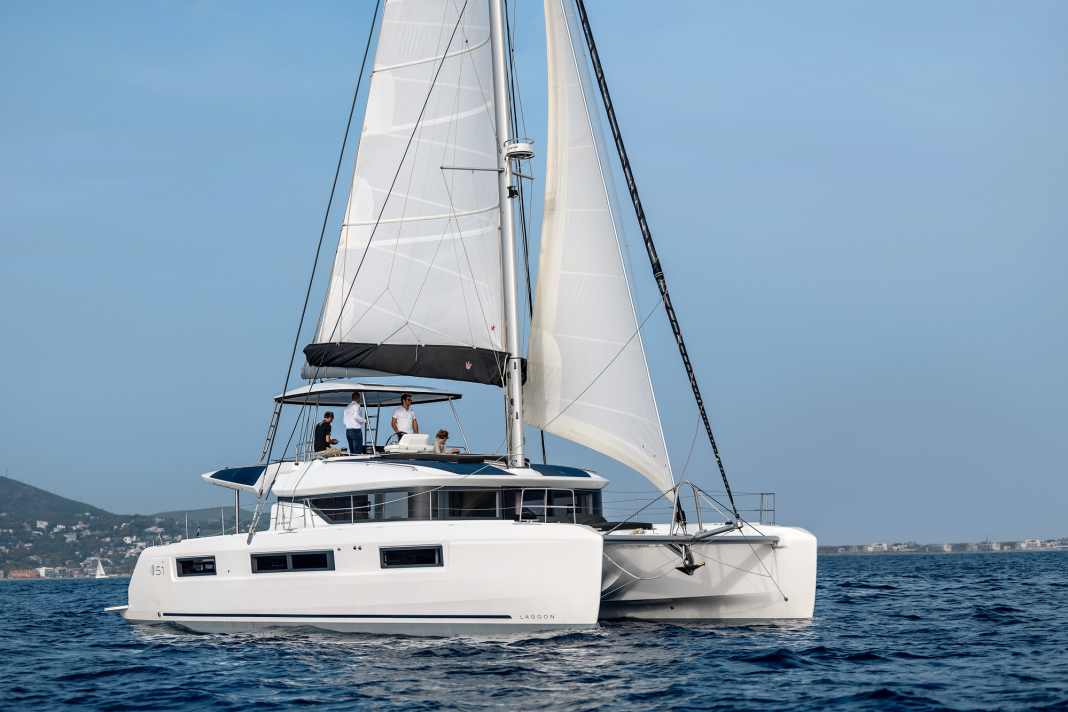





Fifteen metres of hull length is quite a lot of boat. Even more so when it is a cruising catamaran. The new Lagoon 51 is an impressive size in the harbour of Port Ginesta and towers above all the catamarans of the same length on the pier.
In direct comparison with an Excess 14 or a C-Cat 48, it looks like a floating holiday home. Not just as voluminous and comfortable, but also almost as high thanks to the fixed bimini. The GRP canopy measuring a good four by four metres and mounted on stainless steel supports above the flybridge, virtually on the second floor, disfigures the appearance of the boat, but at least it offers protection from the sun and, at least with side tarpaulins, also rain.
The bathing platforms, which are now extended far aft and beyond the side of the hull, are inviting and make it easier to get on board. What's more, they give the cruising catamaran its name - because the new Lagoon 51 is essentially the hull of its predecessor, the Lagoon 50.
The longer sterns are by no means the only changes, as Product Manager Quentin Béraut explains: "The hull is the same, but we've made a few other improvements to the boat." In the original test in YACHT 3/2018, we praised the mast positioned far aft, which "finally made a self-tacking jib of a reasonable size" possible. However, despite good sailing characteristics, Lagoon has now abandoned this option again, as the mast positioned amidships had some disadvantages.
The mast support in the saloon not only impaired the impression of space. The rigging position also required extensive stiffening structures. For this reason, the designers from the VPLP office have now moved the mast to the very front end of the superstructure. "This gave us much more freedom for the interior layout, and the sailing characteristics still remained acceptable," says Béraut, adding: "We don't want to build lame ducks, but living comfort is more important than achieving one decimal place more speed."
The cruising catamaran Lagoon 51 under sail
Instead of the large self-tacking jib, a genoa is now in use again, with which the Lagoon 51 is travelling well. During the test run, the cruising catamaran amazed us with its very fast light wind characteristics and ran at a remarkable 5.2 knots in only ten to twelve knots of wind on upwind courses around 50 degrees. However, the 51 feels a little more comfortable at 60 degrees and gains half a knot. The tacking angle is a good 100 degrees, which makes tacking possible but tedious.
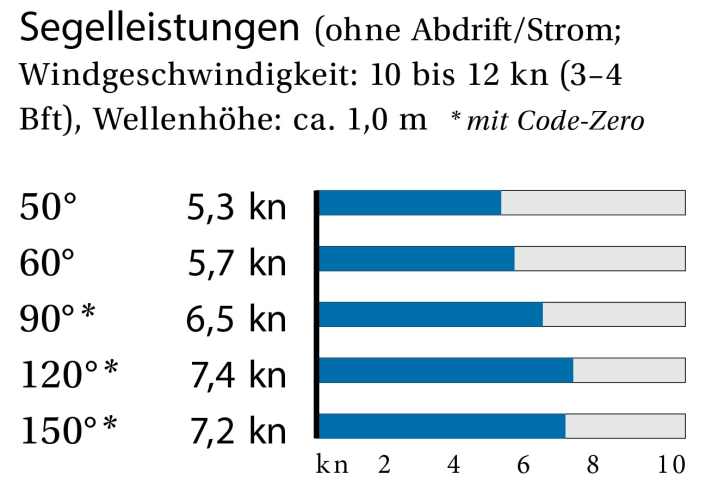
The boat can even reach 6.5 knots at half wind speed. When dropping, we electrically furl the Code Zero, which has to be ordered as an extra, but is a useful upgrade (surcharge: 40,341 euros incl. electric furler). With the extra sail area, the wake begins to rush at an angle of 120 degrees to the true wind and the Lagoon 51 logs 7.4 knots. When the angle drops further to 150 degrees, the log still shows 7.2 knots. Really reasonable values for a cruising catamaran whose boom floats almost seven metres above the waterline, which can accommodate up to twelve guests and already displaces almost 20 tonnes when empty.

There have been hardly any changes on deck apart from the extended bathing platforms. Access to the flybridge is via two spiral staircases integrated into the shape of the deck, although additional stainless steel railings would be desirable in rough seas as the handholds are far apart.
The steering position of the cruising catamaran is exposed
Behind the steering bench on the flybridge, the 50 still had a large sunbathing area, whereas the 51 now has a small table with an L-shaped sofa. This makes better use of the space. The centrally mounted steering wheel is a good height and can be operated perfectly when standing. However, the seating position on the bench is unfavourably far away from the wheel. If you want to use the backrest, your arms are too short to steer.
However, you don't have to intervene much. The boat runs like on rails on all courses, but does not give any feedback from the rudder. Lagoon relies on a hydraulic system because steering ropes would be too long and would have to be redirected many times. In practice, however, such a cruising catamaran will usually be driven with the autopilot anyway.
When testing the Lagoon 50, we already criticised the poor visibility during mooring manoeuvres because it is impossible to see the stern from the midships steering position. Lagoon has now fitted two cameras for this purpose, which do not allow camera-guided reversing (as in a car), but at least help to better estimate the distances to the jetty. The view forwards is still severely restricted by the foresail, as it is not possible to look forwards past the leech from a high position. This would require a window in the sail or another camera with a view ahead.
Overall, the high position on the flybridge gives a feeling of exposure that takes some getting used to, especially in rough seas. This also applies to line work. Almost all of the sheets and outhauls are redirected to electric winches in the cockpit, where they are easy to operate. However, the standing position on the spiral staircase is not ideal, because if the electrics fail, there is no support for powerful cranking.
On top of that, the helmsman remains separated from the rest of the crew if they are in the cockpit aft, one floor below. There are no opportunities for communication or direct visual contact. Lagoon explains this division by saying that there are often two families travelling on such a cruising catamaran and it is easier to avoid each other. But if this is necessary, why do people go sailing together at all?
Very good interior fittings on the Lagoon 51
The interior is veneered in light-coloured Alpi oak with work surfaces in light-coloured Corian and a dark oak floor. The workmanship is convincing down to the last detail and noticeably better than on most other large series cats.
The saloon is slightly elevated, which provides a wonderful panoramic view from the L-shaped sofas. By moving the mast base forward, the shipyard was now able to integrate a third forward-facing sofa and place a fully-fledged dining table (1.20 x 0.70 metres) in the centre of the seating area. Overall, the changes in the saloon have created a feeling of significantly more space, a real gain. A hinged window at the front of the superstructure ensures good ventilation. When cruising, however, it is in danger of being torn off by the sheets if it is fully open. This means that only gap ventilation is possible when travelling.
Where there was a chart table with plotter on the Lagoon 50, there is now an open area without the option of mounting a multi-display. The switch panel is located on the companionway to the starboard hull and, although tidy, is surprisingly small for a 50-foot cruising catamaran. It only has ten buttons and little space for other installations.
The hulls can be equipped with between four and six cabins, depending on the intended use of the yacht. In the four-cabin version we sailed, the entire starboard hull is designed as an owner's suite with a double berth aft (2.02 x 1.64 metres), a sophisticated wet room with separate WC in the bow and a walk-in wardrobe amidships. This creates a stunningly spacious impression, as you can see from the berth to the front wall of the shower on one level for around ten metres.
On the port side of the cruising catamaran, a small guest cabin can be provided amidships instead of the wardrobe, which at first glance appears to be intended for children, but its dimensions are so well designed that even adults can fit comfortably in the 2.00 metre long and 1.15 or 1.38 metre wide berth. The bed is positioned above waist height so that it protrudes sufficiently above the bridge deck. At 0.37 metres, the distance between the door and the berth is just sufficient.
Unlike many other cats, the water, waste water and diesel tanks are located in the centre of gravity in the keels and are extremely generously dimensioned.
With a capacity of 1,040 litres of diesel, the Lagoon 51 is also equipped for extended long journeys. Compared to the Lagoon 50, the water supply has been increased from a rather meagre 480 litres to 830 litres with two additional tanks. For a twelve-berth charter boat, however, the water supply of 70 litres per person is still not enough.
Instead of the previously standard 57 hp Yanmar engines, Lagoon is now supplying the new cruising catamaran with two 80 hp engines. "Almost all customers have always ordered the upgrade anyway, so we have removed the smaller engines from the programme," explains Quentin Béraut.
Demand for the cruising catamaran is high
The Lagoon 51 we tested is build number 1 and was presented at the La Grande Motte trade fair in April. So far there is no second boat. There is a reason for this: "The boat has been travelling with a pair of skippers for six months now and is being put through its paces in practice," says Béraut, "so that we can learn as much as possible for series production. This will only begin once we have analysed the experience." A concept that Lagoon already successfully implemented last year with the 55 cruising catamaran.
The shipyard plans to launch a total of 50 boats a year, just above the Lagoon 46, the current bestseller. "We have already sold a total of 100 of the 51," says Béraut. "If you order a ship today, you won't get it delivered until 2025." The number of pre-orders for the cruising catamaran is impressive when you consider that such a ship costs well over a million euros, even in the basic version, and that the majority of the boats are sold to private owners. "Only 20 per cent go into charter," says Béraut.
The rising cost of building materials is also causing Lagoon problems. While the base price of the Lagoon 50 was still 642,600 euros in 2017, the shipyard is currently asking 1,053,150 euros for the four-cabin version of the 51. "With all the expected changes, we are even expecting a price of 1,158,470 euros from next year," explains Quentin Béraut. The comfort version according to the YACHT definition would then cost around 1.3 million euros.
A lot of money for a floating holiday home, you might think. But for most buyers, it's not. After all, hardly anyone will buy such a catamaran to spend just a few weeks' holiday on it every year. For many buyers, a spaceship like the Lagoon 51 is more of a second or even main residence on the water. And why not?
The Lagoon 51 cruising catamaran in detail
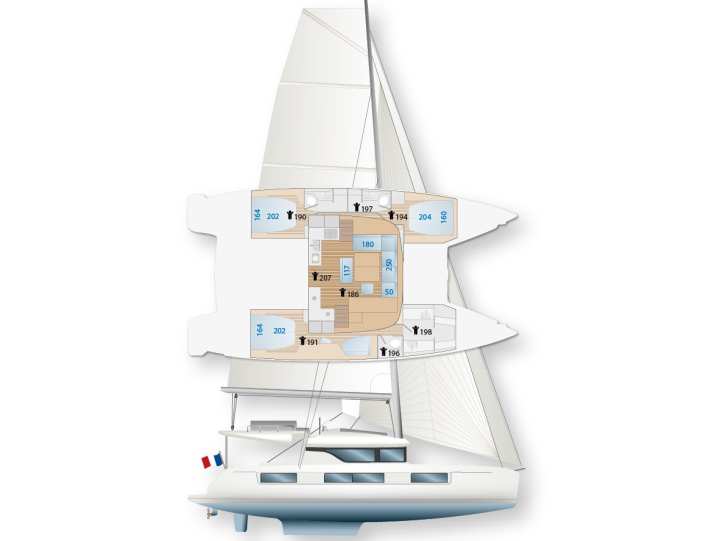
Yacht rating
A very comfortable cruising catamaran that sails well and offers plenty of space. Well-built and well thought-out down to the last detail, with many options for fitting out below deck
Design and concept
- + Functional layout
- + Sturdy construction
- - Exposed flybridge
Sailing performance and trim
- + Light wind properties
- - No view forwards/Lee
- - Winch positions on deck
Living and finishing quality
- + Processing quality
- + Panoramic view in the lounge
- + Noble touch in the finish
Equipment and technology
- + Dimensioning fittings
- + Good installations
- - Hardly any space for navigation
Technical data
- CE design category A
- Total length 15.35 m
- Waterline length 14.31 m
- Width 8.10 m
- Draught 1.40 m
- Mast height above WL 23.53 m
- Theoretical hull speed 9.18 knots
- Weight 19.91 tonnes
- Mainsail 95.0 m2
- Self-tacking jib 53.0 m2
- Code Zero 101.0 m2
- Berths 8 to 12
- Machines (Yanmar) 58 kW/80 hp
- Fuel tank (2) 1,040 litres
- Fresh water tanks (4) 830 litres
- Waste-holding tank 240 litres
Hull and deck construction
GRP sandwich construction with balsa wood core, vacuum infusion process with vinyl ester resins, full laminate under the waterline
Motors
Instead of the usual 57 hp engines, Lagoon now uses 80 hp four-cylinder Yanmar engines as standard
Electronics package
16-inch plotter, log, depth sounder, anemometer, VHF radio and an AIS transponder (all Raymarine) together cost 17,140 euros. Extras include radar equipment (5,580 euros) and stern cameras (3,800 euros)
Expensive gimmicks
The fixed bimini costs 17,040 euros extra, the hydraulic tender lift without dinghy 47,750 and air conditioning/heating as much as 48,910 euros
Equipment and prices
- Base price ex shipyard 1.158.465 €
- Price ready to sail1.183.490 €
- Comfort price 1.296.897 €
- Guarantee/against osmosis 2/5 years
Shipyard
- Lagoon Catamarans, Bordeaux, www.cata-lagoon.com
- Distribution Worldwide dealer network www.lagoon-catamaran.de
Competitors: similar volume, but different concepts
Aura 51
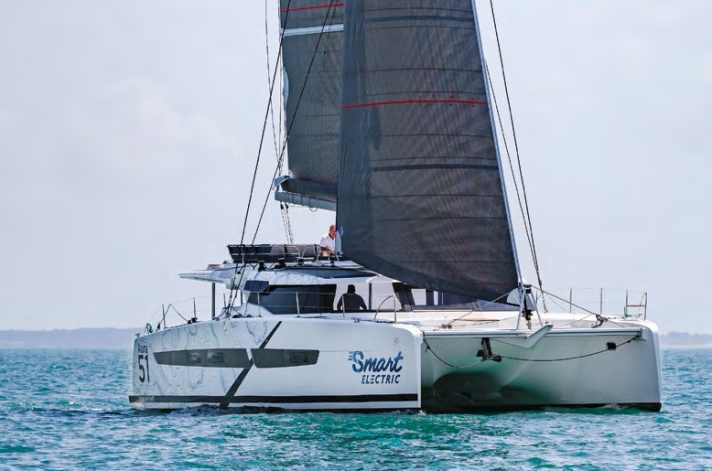
The boat from Fountaine Pajot offers a very generously equipped owner's hull and looks somewhat sleeker than the Lagoon because the flybridge is not so exaggeratedly high. However, the Aura does not stand out excessively.
Hull length 15.54 m; width 8.08 m; weight 18.1 tonnes; from 1,132,692 euros
Catana 48 Ocean Class
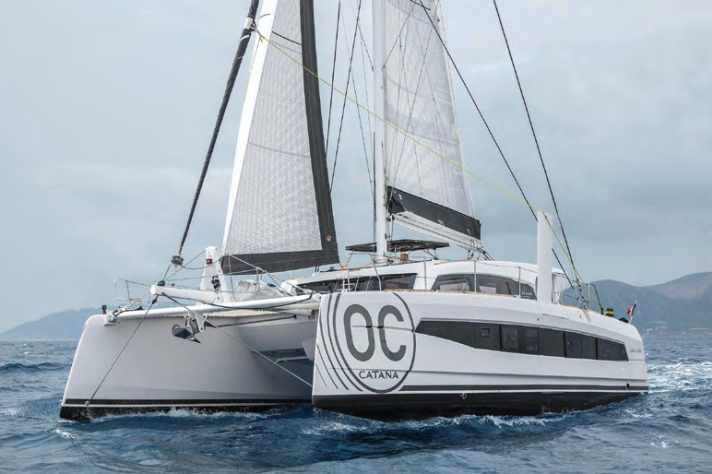
Rebirth of the brand, specially designed for a couple who live on board and sail around the world in comfort. Unconventional layout with navigation/office corner and fully glazed rear area that can be opened.
Hull length 14.99 m; width 7.98 m; weight 13.5 tonnes; from 1,233,673 euros
Excess 15
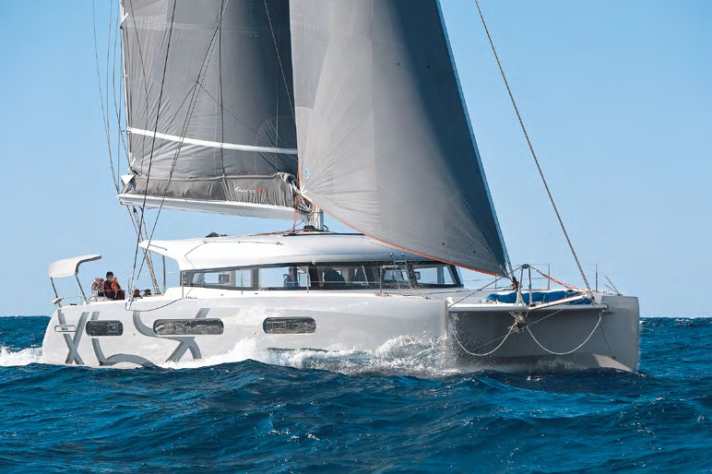
A boat with a rather pragmatic design for sailors who are young at heart. The rudders have been optimised since the test in YACHT 5/2020. The centre section of the hull comes from the Lagoon 50, the outer hull sides and deck from Excess.
Hull length 14.76 m; width 8.03 m; weight 19.05 tonnes; from 975,681 euros

